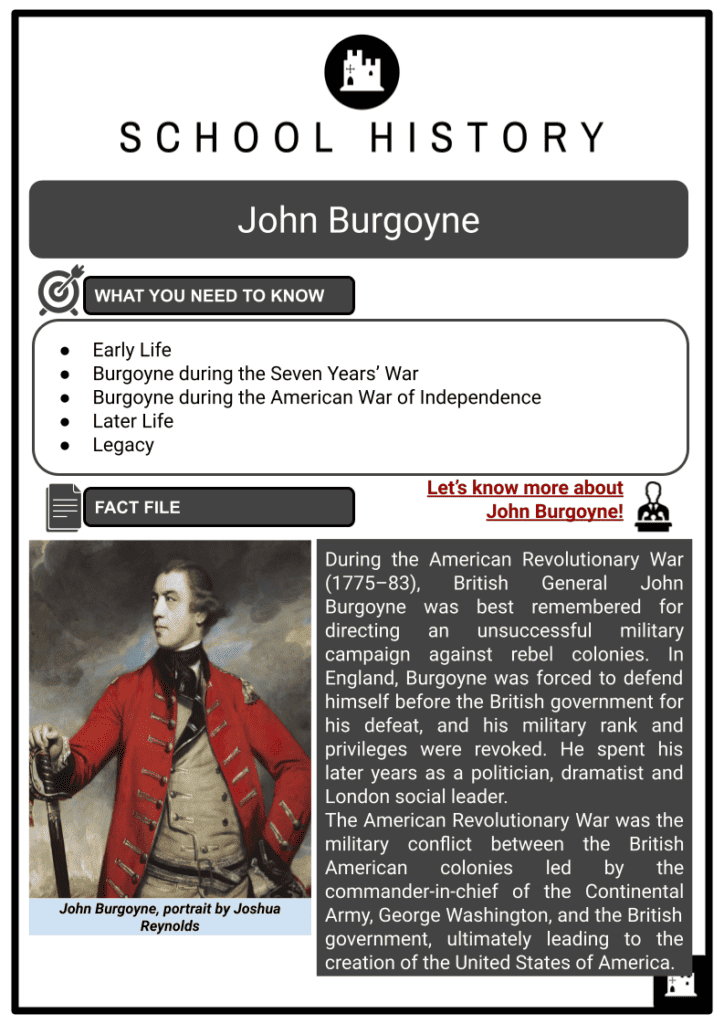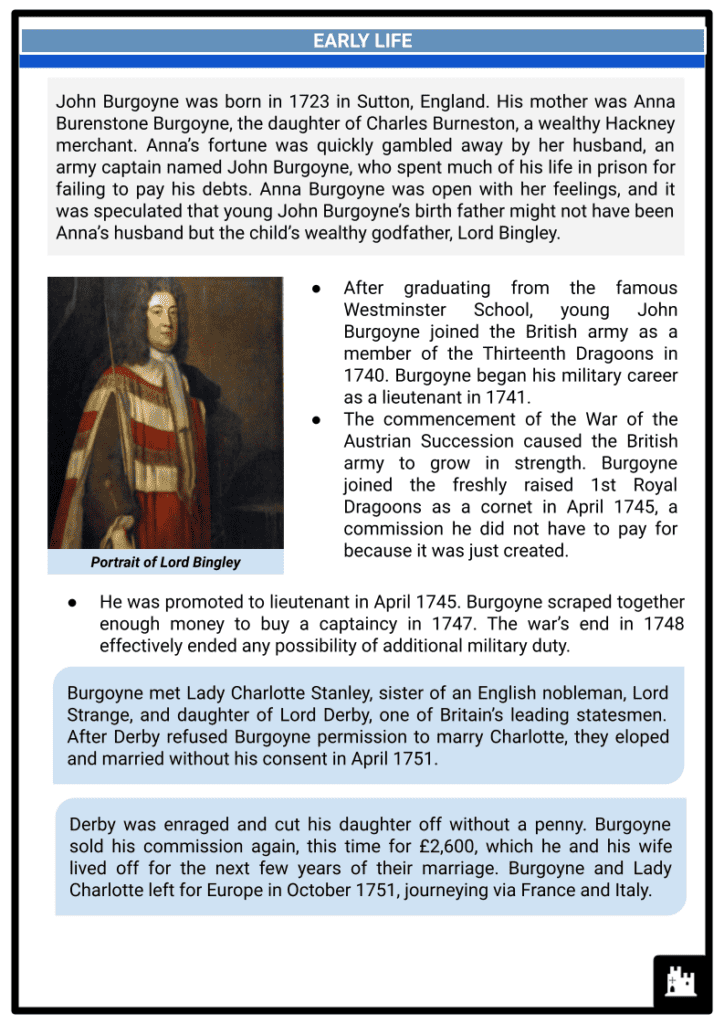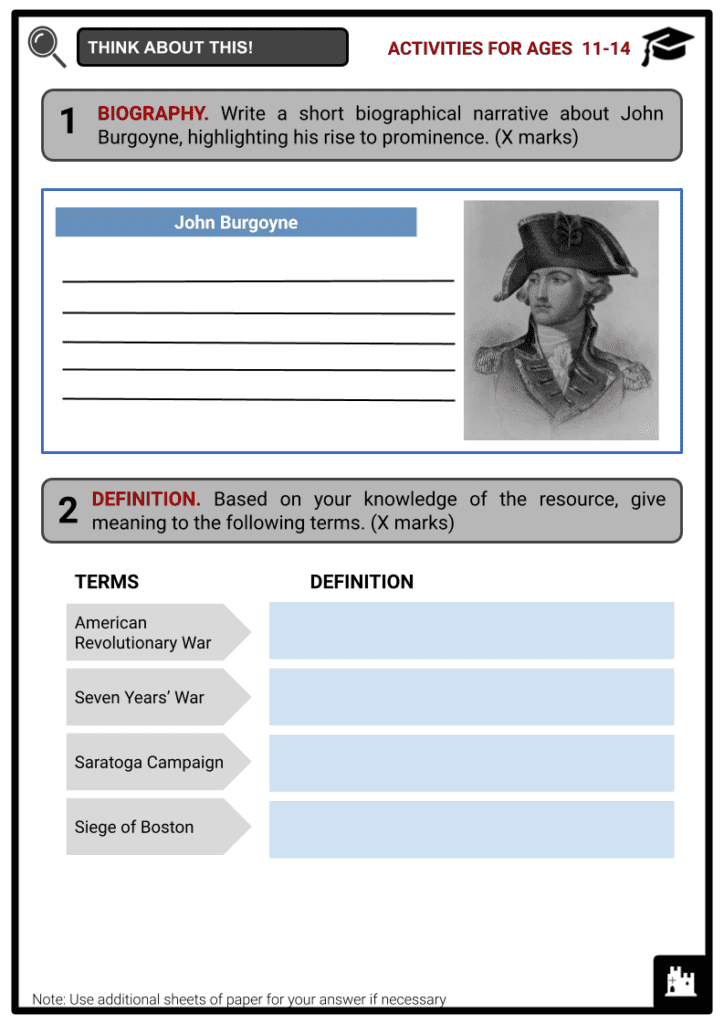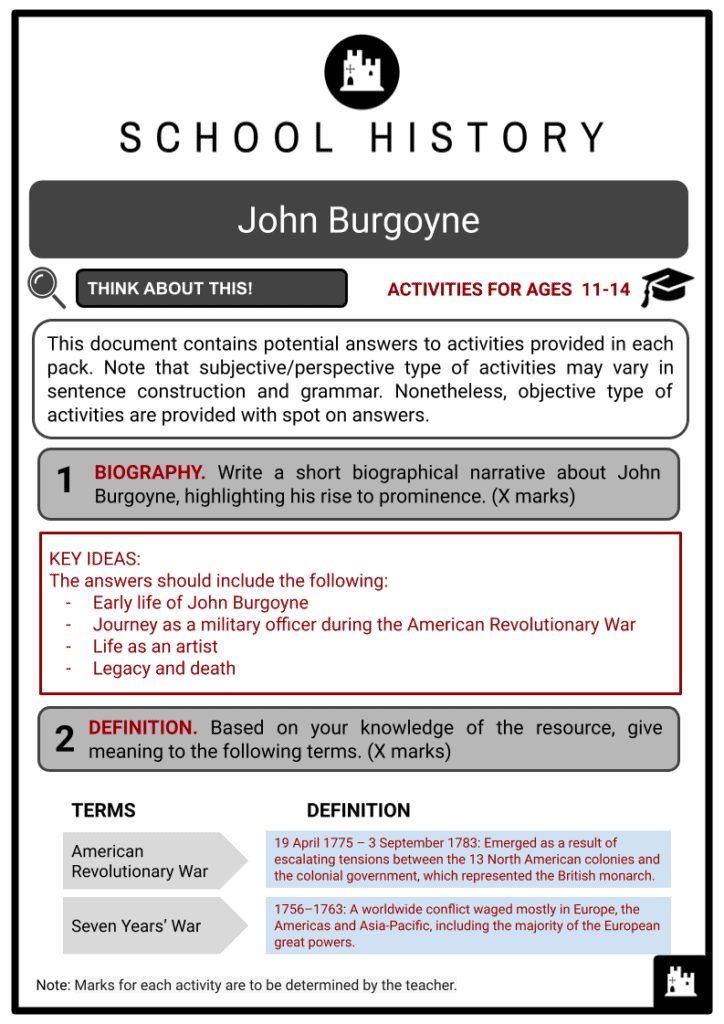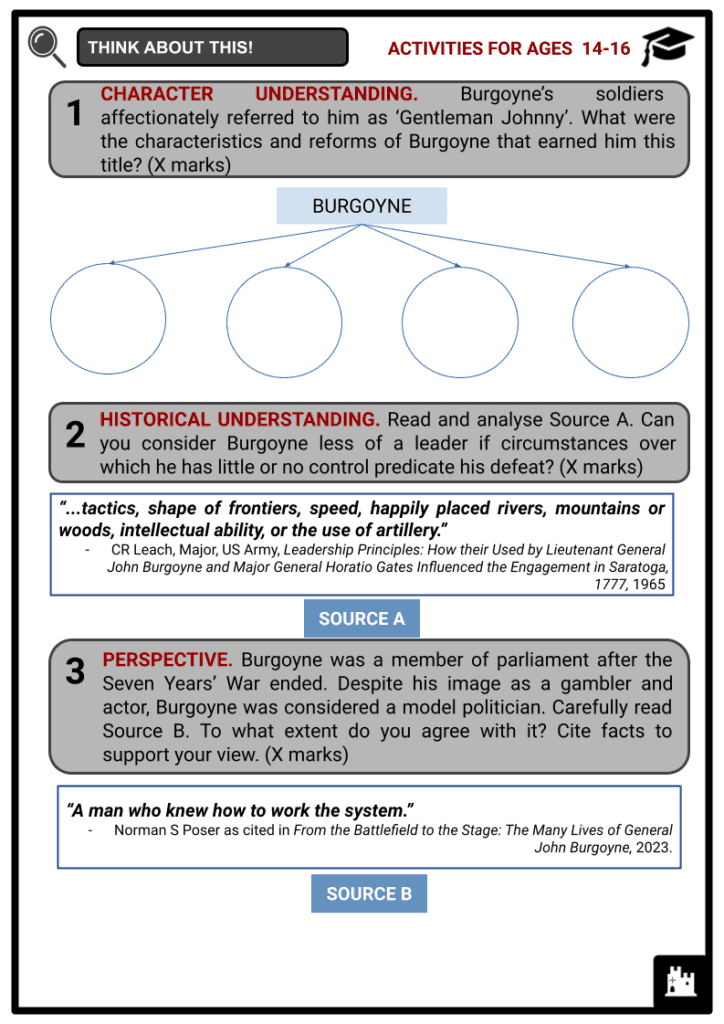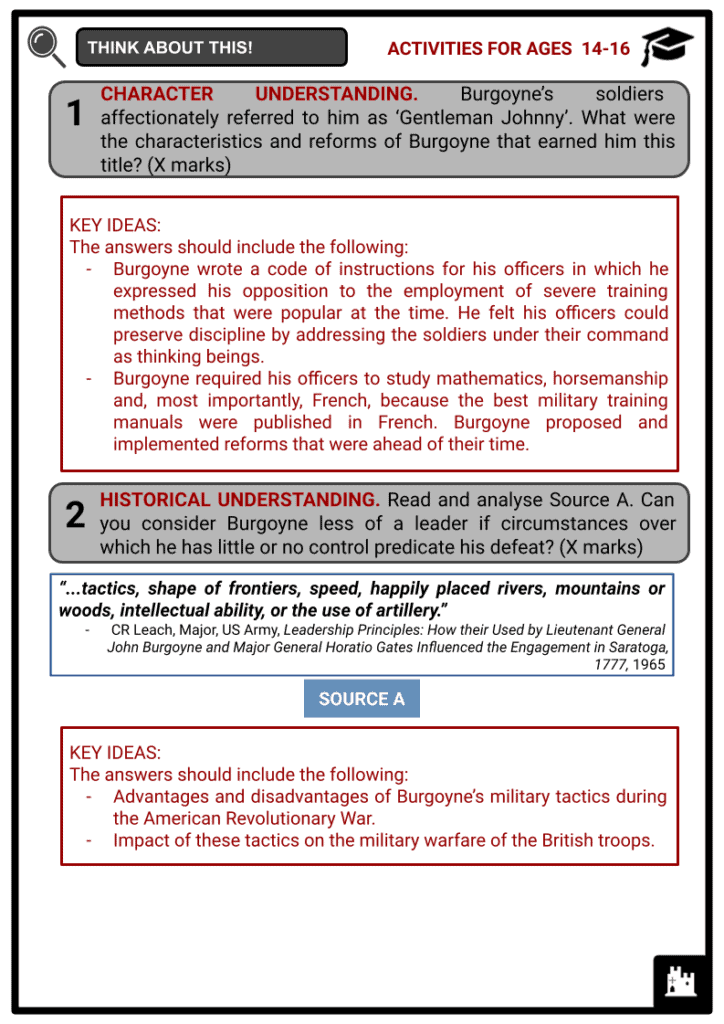John Burgoyne Worksheets
Do you want to save dozens of hours in time? Get your evenings and weekends back? Be able to teach about John Burgoyne to your students?
Our worksheet bundle includes a fact file and printable worksheets and student activities. Perfect for both the classroom and homeschooling!
Summary
- Early Life
- Burgoyne during the Seven Years’ War
- Burgoyne during the American War of Independence
- Later Life
- Legacy
Key Facts And Information
Let’s know more about John Burgoyne!
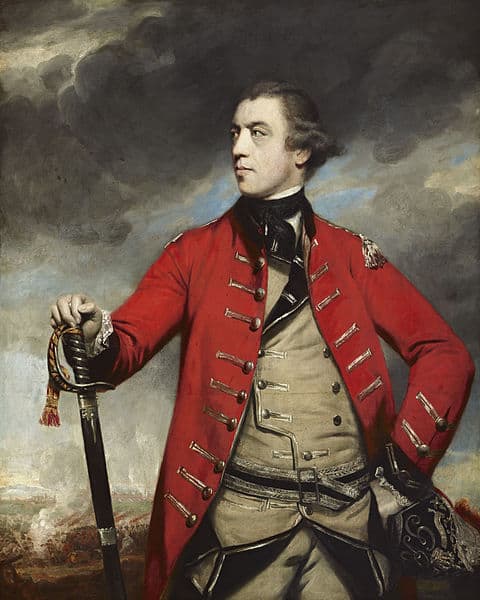
During the American Revolutionary War (1775–83), British General John Burgoyne was best remembered for directing an unsuccessful military campaign against rebel colonies. In England, Burgoyne was forced to defend himself before the British government for his defeat, and his military rank and privileges were revoked. He spent his later years as a politician, dramatist and London social leader.
The American Revolutionary War was the military conflict between the British American colonies led by the commander-in-chief of the Continental Army, George Washington, and the British government, ultimately leading to the creation of the United States of America.
EARLY LIFE
- John Burgoyne was born in 1723 in Sutton, England. His mother was Anna Burenstone Burgoyne, the daughter of Charles Burneston, a wealthy Hackney merchant. Anna’s fortune was quickly gambled away by her husband, an army captain named John Burgoyne, who spent much of his life in prison for failing to pay his debts. Anna Burgoyne was open with her feelings, and it was speculated that young John Burgoyne’s birth father might not have been Anna’s husband but the child’s wealthy godfather, Lord Bingley.
- After graduating from the famous Westminster School, young John Burgoyne joined the British army as a member of the Thirteenth Dragoons in 1740. Burgoyne began his military career as a lieutenant in 1741.
- The commencement of the War of the Austrian Succession caused the British army to grow in strength. Burgoyne joined the freshly raised 1st Royal Dragoons as a cornet in April 1745, a commission he did not have to pay for because it was just created.
- He was promoted to lieutenant in April 1745. Burgoyne scraped together enough money to buy a captaincy in 1747. The war’s end in 1748 effectively ended any possibility of additional military duty.
- Burgoyne met Lady Charlotte Stanley, sister of an English nobleman, Lord Strange, and daughter of Lord Derby, one of Britain’s leading statesmen. After Derby refused Burgoyne permission to marry Charlotte, they eloped and married without his consent in April 1751.
- Derby was enraged and cut his daughter off without a penny. Burgoyne sold his commission again, this time for £2,600, which he and his wife lived off for the next few years of their marriage. Burgoyne and Lady Charlotte left for Europe in October 1751, journeying via France and Italy.
- Burgoyne befriended the Duc de Choiseul, who would eventually become Foreign Minister and drive French strategy during the Seven Years’ War while in France.
- Lady Charlotte gave birth to a daughter, Charlotte Elizabeth, in late 1754. Burgoyne and his wife and daughter returned to Britain in 1755, hoping that a granddaughter would soften Derby’s objection to their marriage.
- Lord Strange intervened on their behalf with Derby, who quickly reversed his decision and welcomed them back into the family. Burgoyne promptly became a favourite of Derby, who used his influence to bolster Burgoyne’s chances.
BURGOYNE DURING THE SEVEN YEARS’ WAR
- A month after the Seven Years’ War began, Burgoyne bought a commission in the 11th Dragoons, a cavalry regiment of the British military. The Seven Years’ War was a worldwide conflict involving most of the great European powers in Europe, the Americas and Asia-Pacific. In 1758, Burgoyne was promoted to captain and lieutenant-colonel in the oldest continuously serving regular regiment in the British army known as the Coldstream Guards.
Raids on the French Coast
- He took part in multiple missions against the French coast in 1758. He was vital in integrating light cavalry into the British army during this time. George Augustus Eliott, a Scottish officer of the British army, and Burgoyne led the two established regiments.
- Burgoyne pioneered the early creation of British light cavalry, which was a groundbreaking step. In direct contrast to the established structure used by the British army at the time, Burgoyne respected independent thought among common troops and encouraged his men to exercise their initiative.
Spanish invasion of Portugal in 1762
- Burgoyne was a member of parliament for Midhurst in 1761, and the following year he served as a brigadier-general in Portugal, which had recently entered the war.
- Burgoyne distinguished himself by leading his cavalry in the conquest of Valencia de Alcántara and Vila Velha de Ródo in the aftermath of the Battle of Valencia de Alcántara, compensating for the Portuguese loss of Almeida. This played a significant role in repelling a strong Spanish force intent on invading Portugal.
- In 1768, Burgoyne was elected to the House of Commons for Preston. In the subsequent years, he was preoccupied primarily with his parliamentary duties, in which he was notable for his general outspokenness and, in particular, his attacks on Lord Clive, who was considered the nation’s leading soldier at the time.
- In 1772, he rose to notoriety by calling for a probe into the East India Company, alleging widespread corruption among its executives. At the same time, he was deeply involved in art and drama (his first play, The Maid of the Oaks, was staged by David Garrick in 1775).
BURGOYNE DURING THE AMERICAN WAR OF INDEPENDENCE
- Burgoyne had been appointed to major-general in the army. He was given a command at the start of the American Revolutionary War and landed in Boston in May 1775, just a few weeks after the start. He was part of the Boston garrison during the Siege of Boston, considered the opening phase of the American Revolutionary War. Burgoyne did not see action during the first phase of the Siege of Boston, which was the Battle of Bunker Hill, which William Howe and Henry Clinton led.
- Dissatisfied with his lack of chances, he returned to England before the remainder of the garrison departed the city in March 1776. In 1776, he led the British forces that sailed up the Saint Lawrence River to relieve the siege of Quebec City by the Continental Army.
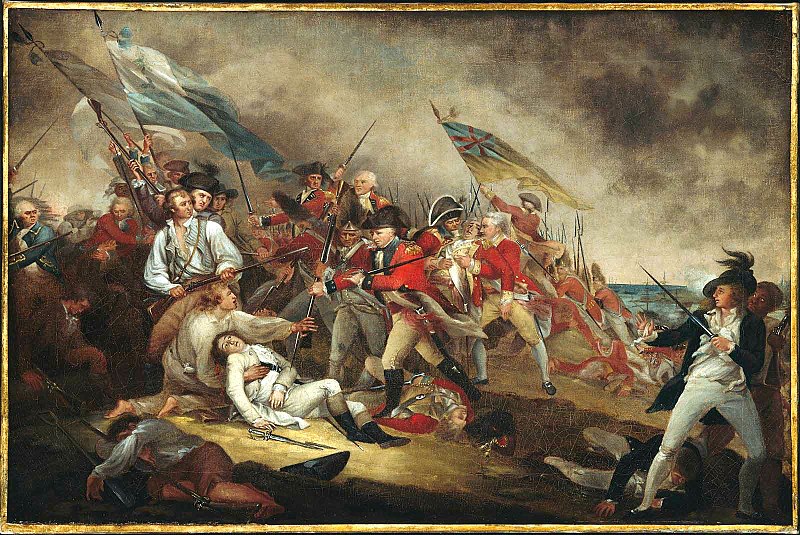
Portrait depicting the death a general during the Battle of Bunker Hill
Saratoga Campaign
- After convincing King George III and his government of the flaws of Guy Carleton, a British army officer, Burgoyne was assigned command of the British forces tasked with regaining control of Lake Champlain and the Hudson River region the following year.
- Burgoyne and his force were to cross Lake Champlain from Quebec and capture Ticonderoga before advancing on Albany, New York, where they would meet up with another British army led by Howe coming north from New York City and a smaller force led by Barry St Leger coming down the Mohawk River valley. This would separate New England from the southern colonies, making it easier to end the insurrection.
- The notion that Burgoyne’s aggressive assault from Quebec would be supported by the movements of two other strong British troops under Generals Howe and Clinton, who would back the advance, was central to the plan.
- However, Lord George Germain, Secretary of State for Colonies’ orders from London, was unclear on this point, so Howe took no action to reinforce Burgoyne, and Clinton arrived from New York too late and in too little a force to be of much use to Burgoyne.
- As a result of this misunderstanding, Burgoyne ended up running the campaign on his own. He was unaware that he would not receive extra assistance and was still optimistic about his chances of success.
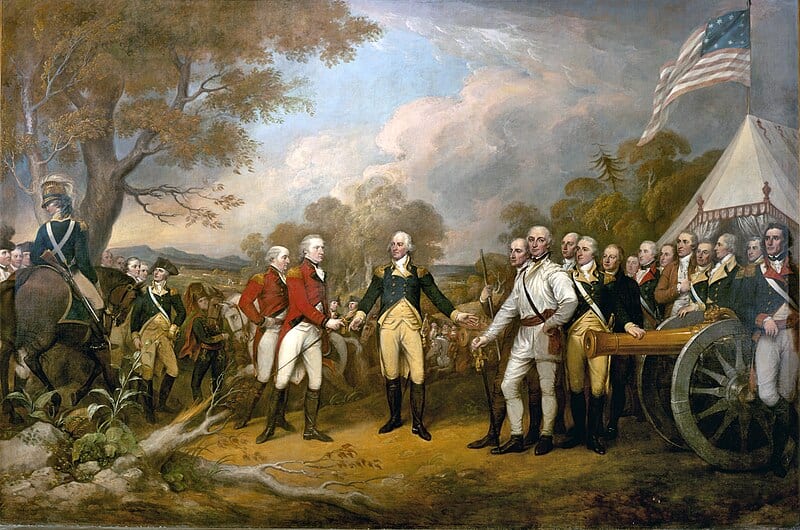
Portrait by John Trumbull depicting the surrender of General Burgoyne - Burgoyne, who had collected an army of about 7,000 troops in Quebec, was also encouraged to believe that he could rely on the backing of vast numbers of American Indians and American Loyalists who would rally to the flag once the British arrived. During the American Revolutionary War, Loyalists were colonists from the Thirteen Colonies who remained loyal to the British Crown.
- Initially, the campaign was successful. Burgoyne took control of the crucial outposts of Fort Ticonderoga and Fort Edward, but he opted to cut off communications with Quebec to press ahead. He was eventually trapped by a larger force led by American Major General Horatio Gates.
- In September and October 1777, several attempts to breach the enemy lines were foiled at Saratoga. Burgoyne surrendered his entire force of 5,800 men on 17 October 1777. This was the most significant victory for American forces up to that point in the Revolutionary conflict, and it proved to be a watershed moment in the conflict, as France allied with the American Patriots.
- Instead of an outright unconditional surrender, Burgoyne agreed to a convention where his soldiers surrendered their weapons and returned to Europe with a promise not to return to North America.
- Burgoyne had been adamant on this point, even threatening to fight back to Quebec if an agreement was not reached.
- Following Saratoga, there was widespread resentment of Burgoyne in the United Kingdom (UK). He returned immediately, with the permission of the American general, to justify his actions and asked for, but never received a trial.
- Burgoyne held the position of governor in Fort William, Scotland from 1769, but lost it together with his military unit.
- On 6 February 1778, following the defeat, France entered the war, causing it to become a global conflict.
- Although Burgoyne was widely blamed for the defeat then, historians have moved blame for the Saratoga tragedy to Lord Germain, the Secretary of State for the Colonies. Germain had overseen the campaign’s general strategy and had notably failed to instruct General Howe to help Burgoyne’s invasion, instead letting him assume he was free to start his attack on Philadelphia.
LATER LIFE
- Burgoyne returned to England in 1778, where he faced severe criticism for his defeat at Saratoga. A government committee appointed to investigate his shortcomings in America judged him guilty of disobedience and negligence of duty, notwithstanding his defence that he lacked sufficient supplies and personnel. King George III chastised Burgoyne for removing part of his military duties. This cut his income in half and stopped his military career.
- Burgoyne spent the majority of his later years attending and creating plays. Burgoyne’s writing fame was reinforced by his amusing 1780 musical comedy The Lord of the Manor, which centred on soldier life.
- Following his wife’s death in 1776, Burgoyne had four children with his lover Susan Caulfield, one of whom was Field Marshal John Fox Burgoyne, father of Hugh Talbot Burgoyne, VC.
- His comedy The Heiress, which premiered in 1786, was clever and well-received. In late 1786, he followed this accomplishment by adapting an opera for the theatre about the English ruler, Richard the Lionhearted, which was a flop.
- Burgoyne died on 4 August 1792, shortly after returning home from a play, with Caulfield by his side. When historians look at Burgoyne’s career, almost all agree that he was more successful as an author than a soldier.
LEGACY
- Historians and critics have frequently described Burgoyne as a classic example of the slightly competent aristocratic British general who rose through the ranks through political connections rather than talent.
- Accounts of his opulent lifestyle on the Saratoga campaign, along with a gentlemanly bearing and his vocation as a dramatist, caused less-than-friendly contemporaries to portray him as ‘a buffoon in uniform who bungled his assignments badly,’ as historian George Billias put it.
- Billias saw Burgoyne as a tough and risk-taking general with a sharp sense of his opponents and an insightful social and political analyst.
Frequently Asked Questions
- Who was John Burgoyne?
John Burgoyne was a British general and politician best known for his role in the American Revolutionary War and his surrender at the Battle of Saratoga in 1777.
- What role did John Burgoyne play in the American Revolutionary War?
Burgoyne is most famous for leading a British campaign in the American Revolutionary War, known as the Saratoga campaign. His forces attempted to cut off New England from the rest of the colonies by advancing from Canada but were defeated at the Battle of Saratoga in 1777.
- Why is the Battle of Saratoga significant?
The Battle of Saratoga is considered a turning point in the American Revolutionary War. Burgoyne's surrender to American forces under General Horatio Gates increased French support for the American cause and boosted American morale.

